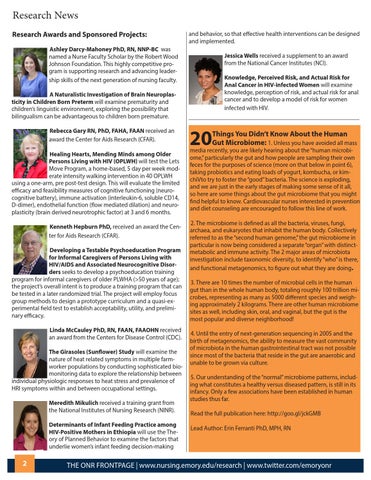Research News Research Awards and Sponsored Projects:
and behavior, so that effective health interventions can be designed and implemented.
Ashley Darcy-Mahoney PhD, RN, NNP-BC was named a Nurse Faculty Scholar by the Robert Wood Johnson Foundation. This highly competitive program is supporting research and advancing leadership skills of the next generation of nursing faculty.
Jessica Wells received a supplement to an award from the National Cancer Institutes (NCI). Knowledge, Perceived Risk, and Actual Risk for Anal Cancer in HIV-infected Women will examine knowledge, perception of risk, and actual risk for anal cancer and to develop a model of risk for women infected with HIV.
A Naturalistic Investigation of Brain Neuroplasticity in Children Born Preterm will examine prematurity and children’s linguistic environment, exploring the possibility that bilingualism can be advantageous to children born premature. Rebecca Gary RN, PhD, FAHA, FAAN received an award the Center for Aids Research (CFAR). Healing Hearts, Mending Minds among Older Persons Living with HIV (OPLWH) will test the Lets Move Program, a home-based, 5 day per week moderate intensity walking intervention in 40 OPLWH using a one-arm, pre post-test design. This will evaluate the limited efficacy and feasibility measures of cognitive functioning (neurocognitive battery), immune activation (interleukin-6, soluble CD14, D-dimer), endothelial function (flow mediated dilation) and neuroplasticity (brain derived neurotrophic factor) at 3 and 6 months. Kenneth Hepburn PhD, received an award the Center for Aids Research (CFAR). Developing a Testable Psychoeducation Program for Informal Caregivers of Persons Living with HIV/AIDS and Associated Neurocognitive Disorders seeks to develop a psychoeducation training program for informal caregivers of older PLWHA (>50 years of age); the project’s overall intent is to produce a training program that can be tested in a later randomized trial. The project will employ focus group methods to design a prototype curriculum and a quasi-experimental field test to establish acceptability, utility, and preliminary efficacy. Linda McCauley PhD, RN, FAAN, FAAOHN received an award from the Centers for Disease Control (CDC). The Girasoles (Sunflower) Study will examine the nature of heat related symptoms in multiple farmworker populations by conducting sophisticated biomonitoring data to explore the relationship between individual physiologic responses to heat stress and prevalence of HRI symptoms within and between occupational settings. Meredith Mikulich received a training grant from the National Institutes of Nursing Research (NINR). Determinants of Infant Feeding Practice among HIV-Positive Mothers in Ethiopia will use the Theory of Planned Behavior to examine the factors that underlie women’s infant feeding decision-making
2
20
Things You Didn’t Know About the Human Gut Microbiome: 1. Unless you have avoided all mass
media recently, you are likely hearing about the ‘‘human microbiome,’’ particularly the gut and how people are sampling their own feces for the purposes of science (more on that below in point 6), taking probiotics and eating loads of yogurt, kombucha, or kimchiVto try to foster the ‘‘good’’ bacteria. The science is exploding, and we are just in the early stages of making some sense of it all, so here are some things about the gut microbiome that you might find helpful to know. Cardiovascular nurses interested in prevention and diet counseling are encouraged to follow this line of work. 2. The microbiome is defined as all the bacteria, viruses, fungi, archaea, and eukaryotes that inhabit the human body. Collectively referred to as the ‘‘second human genome,’’ the gut microbiome in particular is now being considered a separate ‘‘organ’’ with distinctmetabolic and immune activity. The 2 major areas of microbiota investigation include taxonomic diversity, to identify ‘‘who” is there, and functional metagenomics, to figure out what they are doing. 3. There are 10 times the number of microbial cells in the human gut than in the whole human body, totaling roughly 100 trillion microbes, representing as many as 5000 different species and weighing approximately 2 kilograms. There are other human microbiome sites as well, including skin, oral, and vaginal, but the gut is the most popular and diverse neighborhood! 4. Until the entry of next-generation sequencing in 2005 and the birth of metagenomics, the ability to measure the vast community of microbiota in the human gastrointestinal tract was not possible since most of the bacteria that reside in the gut are anaerobic and unable to be grown via culture. 5. Our understanding of the ‘‘normal’’ microbiome patterns, including what constitutes a healthy versus diseased pattern, is still in its infancy. Only a few associations have been established in human studies thus far. Read the full publication here: http://goo.gl/jckGMB Lead Author: Erin Ferranti PhD, MPH, RN
THE ONR FRONTPAGE | www.nursing.emory.edu/research | www.twitter.com/emoryonr
